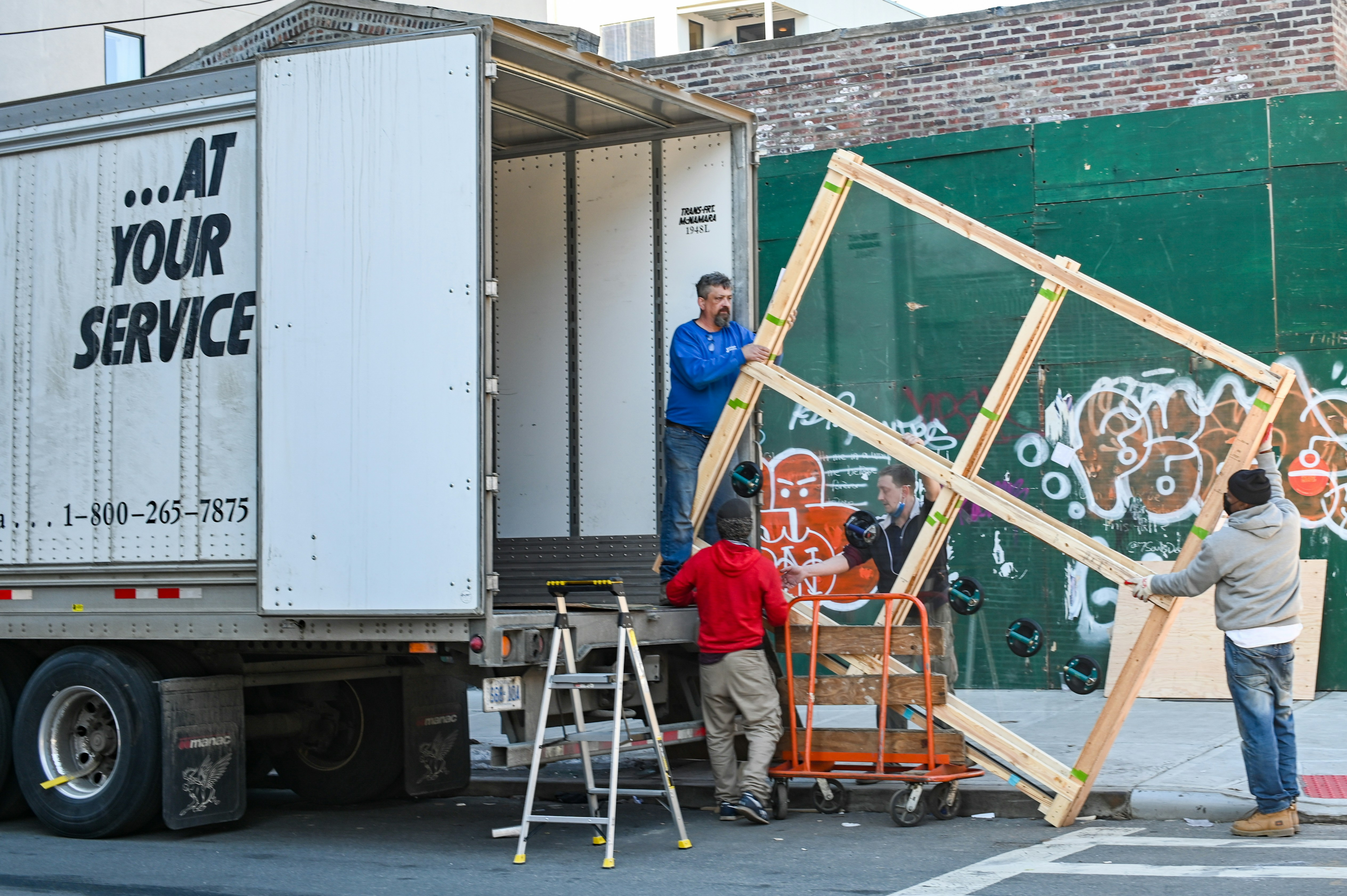
Tipping is common in many service industries, including moving.
While there are no strict rules, some guidelines can help.
Factors like the move’s difficulty, service quality, and mover professionalism can influence your tip. Consider a more generous tip if your movers handled your belongings carefully, navigated tricky staircases, or worked in extreme weather. The move’s length and number of movers also affect the tip amount. Overall, tipping acknowledges and rewards your moving team’s hard work.
In this post, we’ll dig into:
- Why Should You Tip Movers?
- How Much Should You Tip?
- Factors to Consider When Tipping Movers
- Quality of Service
- Size and Complexity of the Move
- Final Moving Cost
- How Much to Tip Movers: Best Practices
- Calculating the Tip
- When to Tip Movers
- How to Tip Movers
- Tipping Etiquette
- Providing Food to Movers
- Factors that Affect a Good Tip
- Tip Movers FAQ
Let’s get started.
Why Should You Tip Movers?

First, let’s address why you should tip your movers.
Movers often carefully handle heavy and valuable items, maneuvering them through tight spaces and up and down stairs. They also work long hours to ensure your belongings are safely transported from one location to another. Tipping is a way to show appreciation for their hard work and effort. Additionally, movers are often paid hourly and may not receive a large portion of the overall cost of your move. Tips can help supplement their income.
How Much Should You Tip?

Aside from service quality, other factors affect tipping. If your move was difficult due to stairs, narrow hallways, or heavy items, consider tipping more to acknowledge the extra effort. Similarly, if you have a large team of movers, tip each individual rather than giving a lump sum.
3 Factors to Consider When Tipping Movers
Aside from the quality of service, there are other factors to consider when deciding on a tip amount. For example, if your move was particularly difficult due to stairs, narrow hallways, or heavy and awkward items, you may want to tip more to acknowledge the extra effort your movers put in. Similarly, if you have a large team of movers assisting with your move, you must tip each individual rather than giving one lump sum.
1. Quality of Service
Exceptional service from movers should be rewarded with a larger tip, especially when they show professionalism and efficiency. Conversely, poor attitude, damage, or delay may warrant a smaller tip or none at all. Tip amounts should reflect overall satisfaction, including the movers’ communication, efficiency, and courtesy.
2. Size and Complexity of the Move
The size and complexity of your move can also influence the amount you tip. If you have a larger home or are moving long distances, it’s understandable to tip on the higher end of the standard range. Conversely, a lower tip may be appropriate if you have a more minor move with fewer items and minimal challenges.
- More significant moves with heavy furniture, multiple flights of stairs, or fragile items may require a more generous tip. Movers who handle particularly challenging tasks deserve recognition for their hard work.
- Consider the movers’ extra effort and hard work when deciding the tip amount. These factors should influence your tipping decision if they have to navigate tight spaces or handle especially delicate items.
- Tip more for good service and less for poor service. Assess whether the movers maintained a steady pace and demonstrated skill in their work. Consider a higher tip if they exceed your expectations above and beyond.
Tipping your movers shows appreciation for their hard work and acknowledges their service. Consider the complexity of your move, the movers’ professionalism, efficiency, and overall service quality to determine an appropriate tip. Rewarding excellent service encourages high standards in the moving industry.
3. Final Moving Cost
A common tipping guideline for moving services is 15-20% of the total cost. For example, a $1,500 move might warrant a $300 tip. Adjust the amount based on service quality and complexity.
How Much to Tip Mover’s Best Practices

Following some best practices is helpful when determining how much to tip your movers. Consider the specific factors and scenarios that can influence the appropriate tip amount, ensuring you provide a fair and appreciative gratuity for their services. Here are some key points to keep in mind:
- A good rule is to tip 15 to 20 percent of the total moving bill for long-haul and local moves. This ensures fair compensation for the entire moving team.
- Tip each team separately, with each getting half the amount, especially for long-distance moves. This ensures that everyone involved in the process is acknowledged.
- Consider factors such as the quality of service, difficulty of the move, size, and additional services when determining how much to tip. These elements can significantly impact the overall effort required by the movers.
- Tipping your movers after the move is generally best, which means tipping them after unloading. This allows you to evaluate the entire service before deciding.
- Tip at the end of the move once it’s complete. This timing ensures that the tip reflects the movers’ performance throughout the job.
How to Tip Movers

You have multiple options to consider when tipping movers, including:
- Tipping movers can be done individually or given to the lead mover, with cash being the preferred method for its immediacy and simplicity.
- Ensure the tip is divided evenly among the crew, promoting fairness and recognizing everyone’s effort.
- For smaller moves, consider tipping each mover directly. Handing the tip to the team leader for more significant moves can streamline the process.
- While cash is preferred, alternatives such as checks, credit cards, Venmo, Cash App, or similar money transfer apps can also be used.
Tipping movers is crucial to show appreciation for their hard work and service quality. Consider factors like move complexity, professionalism, and overall satisfaction to determine a fair tip that acknowledges their efforts and promotes high standards in the moving industry.
Tipping Etiquette

There are some common questions and etiquette guidelines to keep in mind regarding tipping movers. Here are some frequently asked questions and answers to help you navigate the tipping process:
- Show your movers appreciation by passing out bottled water and snacks or buying them lunch. These small gestures can make a big difference in their day.
- Offer to donate or dispose of unwanted furniture and point out the bathroom for their use. This shows consideration for their comfort and needs.
- Thank every person who helped, and consider reporting a successful move to the supervisor or moving company. Positive feedback can help movers in their future endeavors.
- When they arrive: Timeliness is a crucial indicator of professional service.
- How fast they progress: Speed and careful handling of items can reflect the movers’ experience and dedication.
- What type of items they move (e.g., heavy, fragile): Specialized handling should be recognized.
- Rude or careless behavior: This should result in a lower or no tip, as a professional demeanor is essential.
Tip Movers FAQ

What is a good rule of thumb for tipping movers?
Answer: A good rule of thumb for tipping movers is to tip 10 to 20 percent of the move amount for each mover. This range allows for flexibility based on the quality of service.
How should I determine the amount to tip movers?
Answer: Tip based on the quality of the job done, including handling fragile items and going above and beyond. Exceptional service warrants a higher tip.
Should movers be tipped more for long-distance moves?
Answer: Movers should be tipped more for long-distance moves, with a range of 40-50 dollars per mover. These moves are typically more demanding and time-consuming.
Is it OK not to tip movers?
Answer: While tipping is not mandatory, it is customary to tip movers for their hard work. If the service is subpar, you might choose not to tip, but it is generally expected for satisfactory or exceptional service.
When should I give movers their tip?
Answer: You should tip the movers at the end of the move, after all the work has been completed and you have assessed the quality of their service.
Should I tip movers individually or give a lump sum to the foreman?
Answer: It is usually best to tip each mover individually to ensure everyone receives their fair share. However, if you prefer, you can give a lump sum to the supervisor and specify how you would like it divided among the crew.
Is there a difference in tipping rates for local vs. long-distance moves?
Answer: Yes, there is a difference. The tip is typically 10-20% of the total cost for local moves. Due to the increased difficulty and time commitment, a flat rate of 40-50 dollars per mover is more common for long-distance moves.
Can I tip movers with something other than money?
Answer: While cash is preferred, you can also show appreciation by providing meals, snacks, or drinks. However, a monetary tip is still the most appreciated form of gratitude.
What if I can’t afford to tip the recommended amount?
Answer: If you cannot afford to tip the recommended amount, tip what you can and consider offering refreshments or a thank-you note to express your appreciation. Any gesture of gratitude is better than none.
Conclusion

Tipping movers is essential to acknowledging their hard work and ensuring they feel appreciated for the service they provide. You can determine a fair and meaningful tip by considering factors such as the complexity of the move, the level of professionalism displayed, and your overall satisfaction with their performance.
Remember that tipping is not just about the financial reward but also about showing gratitude and respect for their efforts. Alongside monetary tips, small gestures like providing snacks, water, or positive feedback can significantly enhance the movers’ experience.
Ultimately, by valuing the movers’ contributions and following these guidelines, you can foster a positive and respectful interaction, making your moving process smoother and more pleasant for everyone involved.
GET IN TOUCH
Find Storage Units Near You!
Storage Unit Size Guides
5×5 Storage Unit Guide
GET IN TOUCH
Find A 5×5 Storage Unit Near You!
5×10 Storage Unit Guide
GET IN TOUCH
Find A 5×10 Storage Unit Near You!
10×10 Storage Unit Guide
GET IN TOUCH
Find A 10×10 Storage Unit Near You!
10×15 Storage Unit Guide
GET IN TOUCH
Find A 10×15 Storage Unit Near You!
10×20 Storage Unit Guide
GET IN TOUCH
Find A 10×20 Storage Unit Near You!
10×25 Storage Unit Guide
GET IN TOUCH
Find A 10×25 Storage Unit Near You!
10×30 Storage Unit Guide
GET IN TOUCH
Find A 10×30 Storage Unit Near You!
New SecureSpace Self Storage Facilities
SecureSpace Self Storage Maspeth Queens

59-20 Borden Ave, Maspeth, NY 11378
SecureSpace Self Storage Miami Coral Way

2811 Coral Way, Miami, FL 33145
SecureSpace Self Storage Downtown Los Angeles

1535 Essex St, Los Angeles, CA 90021
SecureSpace Self Storage Van Nuys

SecureSpace Self Storage Rancho Penasquitos

10389 Azuaga Street, San Diego, CA 92129
SecureSpace Self Storage Livingston

644 W Mount Pleasant Ave, Livingston, NJ 07039
SecureSpace Self Storage Philadelphia Glenwood

2501 N 15th St, Philadelphia, PA 19132
SecureSpace Self Storage Langhorne

SecureSpace Self Storage Manhattan

424 East 90th Street, New York, NY 10128
SecureSpace Self Storage College Point

131-21 14th Ave, College Point, NY 11356
SecureSpace Self Storage Seattle Greenwood

9309 Aurora Ave N, Seattle, WA 98103
SecureSpace Self Storage Elmsford

Checkout Some Of Our Teams Favorite Articles

- California – Northern Self Storage
- Antioch, CA
- Berkeley, CA
- Los Gatos, CA – Farley
- Los Gatos, CA – University
- Milpitas, CA
- Richmond, CA
- San Jose, CA – Hedding
- San Jose, CA – Lonus
- San Jose, CA – Teresa
- San Leandro, CA















